Shop for Tecnica Cochise backcountry skiing and freeride boots.
Que Macho (or in Apache as Cochise would have perhaps said, “Ik aa’ye iidenka ashii nadndaal. ei nanlwogo aniile shiiyii’ii.Â, look it up), Tecnica has upped the anti with their tech compatible freeride backcountry skiing boot series. The shoes are named after competition rodeo bulls, one of whom is named after the Apache warrior/leader who’s become part or our western legend. All good, but can a boot named in honor of bulls and fighters hold up to the WildSnow tech fitting ANSI approved tractor pull?
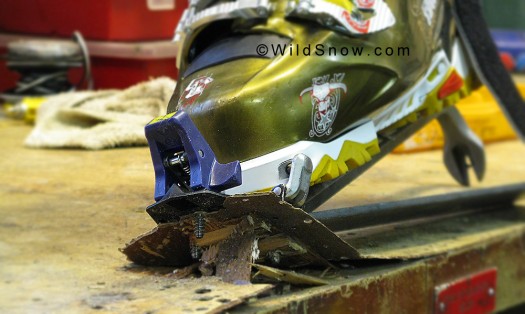
Results of tractor pull powered by my ANSI approved pry bar -- it looks like answer to above question is YES. Tecnica's version of tech fittings stayed true, force I applied ripped binding out of workbench it was screwed to with extra long screws. The boot fitting deformed a tiny amount during this extreme test, but the force I applied was in my opinion way beyond anything it would receive in normal skiing. Thus, I give this a 100% pass as well as a thumbs up for Tecnica's extra effort at making their fittings ultra reliable for big skiers with big boots and big skis.
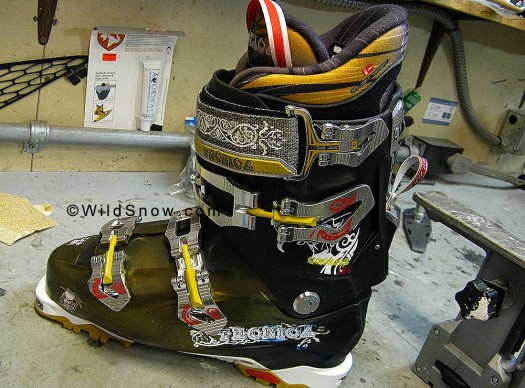
Cochise is probably Tecnica's most 'backountry friendly' freeride boot. Two liner options are available. I used the lighter but slightly softer 'light' liner. Total weight of my size 27.5 Cochise with light liner is 68.5 oz, 1938 gr, per boot. Not bad for a full-on beefer.
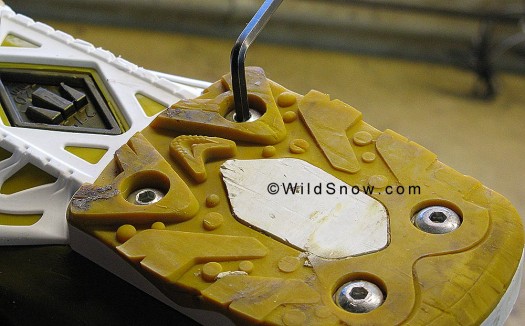
Sole swap blocks are attached with large button head machine screws that thread into an internal double-T-nut. This is one of the the strongest sole attachment systems I've seen yet. I ground down this set of blocks so they'd work in alpine bindings yet still snap into a tech binding such as Dyanfit. Cool.
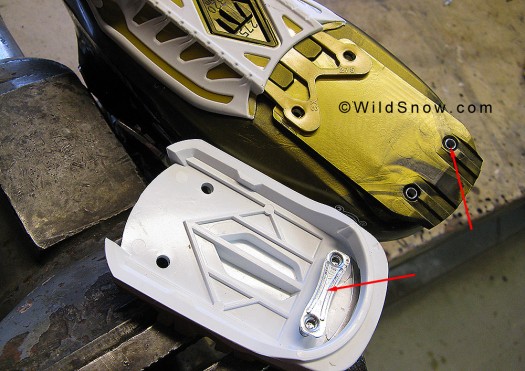
Arrow points to double-t-nut. Displayed on inside of sole block for demonstration, T-nut is actually located inside of boot shell. In the case of the toe tech fitting, the sole block attachment screws actually go through the fitting, thus sandwiching everything together. As far as I could tell, Tecnica's sole block system has nearly zero wobble or play. Boot 'shoe' without sole block is shown to right, arrow indicates holes where sole block fastener goes.
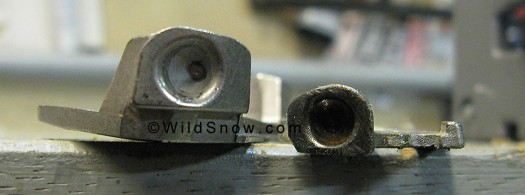
Tec fitting comparison, Tecnica to left is quite substantial and boasts more metal surface area to the outside than most tech fittings, thus preventing boot damage as well as making binding entry easier. To right is typical fitting you'll find in many tech compatible boots, it's strong enough for most skiers, but as boots and skis get bigger, perhaps thicker fittings are a necessary trend. Note that tech fitting failure is rare, but the Solomon tech fitting debacle of last spring means we need to cover every company's tech fittings as thoroughly as possible.
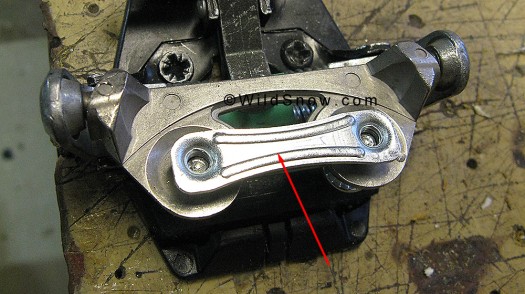
Tecnica tech fitting in tech binding, with double-T-nut attached for demonstration. Nice to see Tecnica's effort to make their fittings ultra strong.
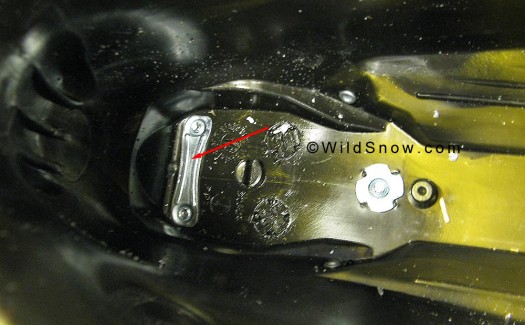
View inside Tecnica Cochise boot shell lower shoe, showing how doubt-T-nut backs attachment of sole blocks. In the case of the tech toe fitting, the attachment screws go right through the fitting and sandwich everything together in logical fashion.
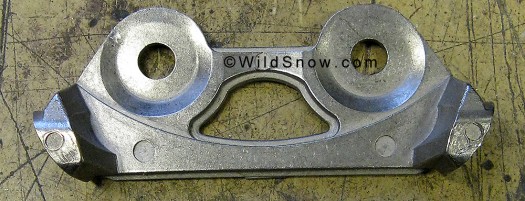
Another view of the Tecnica boot toe tech fitting. I have to say I like the looks of this thing. The large holes are where the sole block attachment screws pass through the fitting.
Ok, that’s it for worship of the Tecnica boot toe tech fitting. How about the heel fitting? Somewhat similar to other makers, but note that the Tecnica heel fitting attachment screw goes all the way through the sole block into the lower backcountry skiing boot shell. That is good, but will require backing out the fitting screw to remove the sole block, which will in turn eventually wear out the threads cut by the screw in the boot plastic. Another thing I noticed about the heel fitting is that the reinforcement/locating nibs are press fit into the sole block, thus eliminating play. I’ll give the heel fitting a 100% pass, but as with most other boot makers who use screws to attach their rear tech fittings, I’d like to see a bigger screw or beef added by some other means.
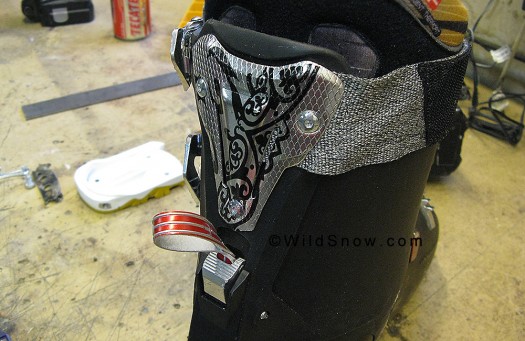
View of rear beef and ski/walk mode latch. You pull up on the loop for walk mode, and press down on the metal part of the latch to return to ski mode.
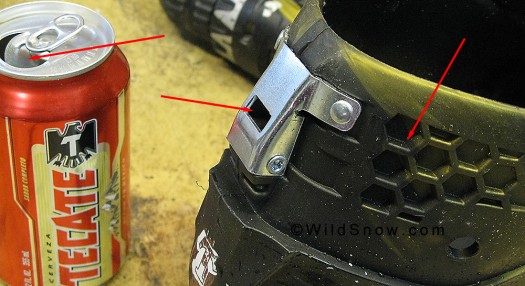
Cuff removed from boot to display mode latch foundation. Latch nib inserts in hole indicated by red arrow. Which red arrow? We trust our readers can figure it out.
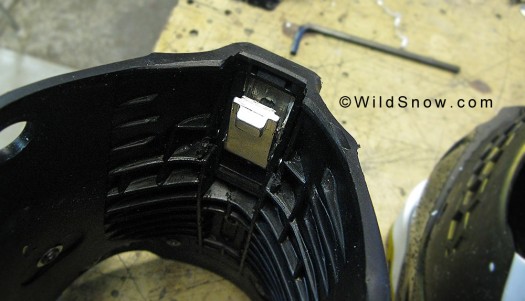
Tecnica mode latch inside boot cuff. The latch is a simple spring loaded nib which inserts in the hole shown in photo above. In my opinion the spring should be stronger, but consumer testing will tell the tale. Mode latches are a common weak point of newly launched freeride backcountry skiing boots, and extensive field testing is the only way to totally vet them.
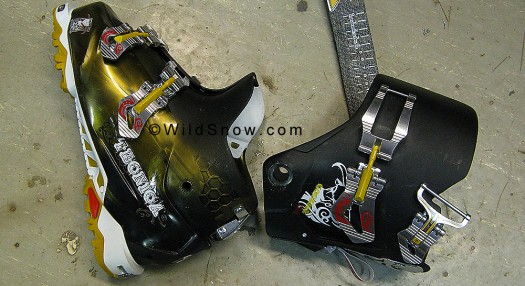
We're always ramping things up here at WildSnow HQ. I've made a commitment to do ever more thorough boot evaluations, which will often include a nearly complete disassemble of the thing so we can look at parts such as the mode change machinery. Should I put it back together myself, or send it back to the company in parts? Probably the former, but if I didn't like someone at a boot company I suppose I could mail the boot back in stages, like the mob mailing a kidnap victim's ear, then their finger, and so forth (just kidding, I like everyone).
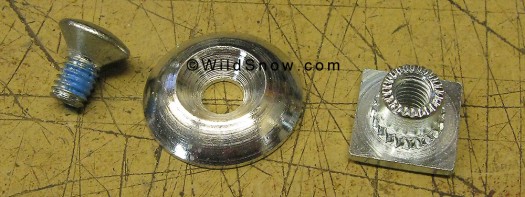
Lucky for me and my relationship with boot makers, Garmont is selling this cool cuff pivot screw rivet. Yes, I won't have to send the Tecnica Cochise boots back in parts. The Garmont fastener is mainly for repairs of worn out ski boot cuff rivets, but super nice to have for mods or evaluations that require removal of the upper ski boot cuff. That said, as always I wish all boot makers would simply make all their boot fasteners user serviceable.
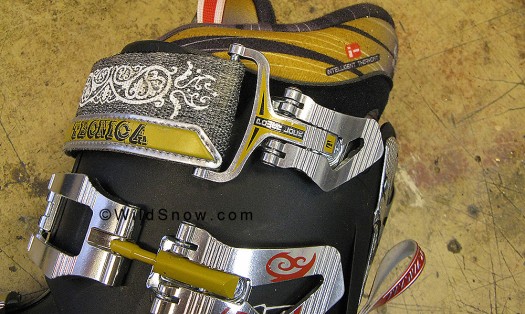
Tecnica hybrid power strap takes the place of both upper buckle and independent power strap. It works quite well, mostly by eliminating the herky jerk most people do with their power straps (you just snug down the strap then flip the buckle, for as much cinch as you want.
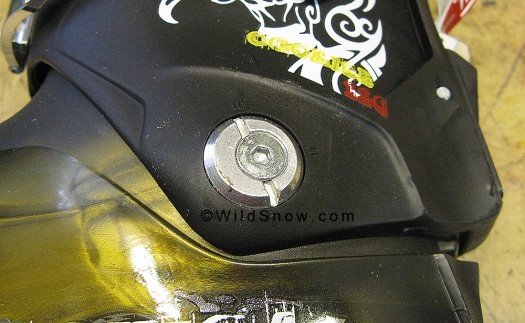
As with many quality ski boots, Tecnica provides cuff alignment. It's been said here that such 'cant rivets' don't allow enough adjustment to make a difference. We beg to differ, though it's possible that too much cuff cant can interfere with walk/ski mechanism. Another method of changing cuff alignment is to simply pad one side of the boot liner cuff.
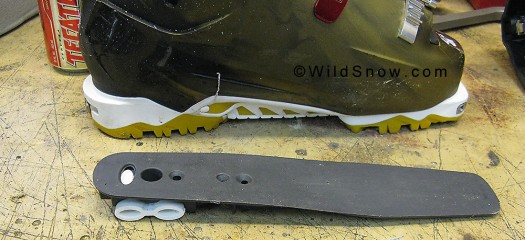
One thing I really like about freeride boots is that many have alpine type boot boards that can be tuned for delta and cant. This is the one you find inside a Tecnica. Interestingly, it is molded with the name 'Demon,' indicating it is cross compatible with other more alpine category Tecnica boots.
While the Tecnica Cochise won’t be my go-to backcountry skiing boots (I use lighter stuff), I did give them a good test during that day of powder snowcat skiing last week, as well as some walking. Luckily Tecnica sent me a rather small shell size for my feet (320 mm), so once I heat molded the liners I got a near perfect heel fit. My toes were a different matter, but as these are PU shells the toe was easy to blow out a half size or so. I’m not a good evaluator of boot stiffness, but these overlap cuff guys are noticeably stiffer than my ZZero Green Machines, with a sweeter flex. They’re rated by Tecnica as a flex 120, but as always we warn you that flex numbers are only a rough guide to boot stiffness, not any sort of industry standard.
Due to my use of the softer ‘light’ liner, my tester Cochise had a bit of extra give I found to my liking for powder and crud, but might be better eliminated for performance skiers by using a denser liner. (This is a good place to say that if you don’t know it already, please know that your liner choice has a HUGE influence on how stiff a boot skis and how it flexes – experiment.)
I found the Tecnica hybrid buckle power strap system to be super effective. For me, it combines the function of both a top buckle and a strap, but those of you used to taller boots might find they want a taller rear spoiler and additional strap. Small spacer spoilers are included that velcro to the front and back of liner, but these are more spacers than they are spoilers. Easy aftermarket mod.
Another thing I liked about this boot was the section of flexible plastic in the lower overlap, intended to make entry and exit easier. I’m a good tester for that with my fused ankle, and can testify that it does work. But if I was skiing these boots much I’d still probably cut away some plastic to make entry easier.
Cochise cuff mobility in walk mode is excellent, but again, much of that depends on your liner choice. Forward cuff lean is not adjustable, and appears difficult to modify mechanically (though one can always play around with liner thickness behind calf).
Not much to say about the Tecnica liner. Basic stroble construction with what feels like foam of adequate density to compromise between performance, weight and comfort for backcountry skiing. They need a pull loop on the rear as well as on the tongue, that’s my only gripe.
In all, a fairly beefy boot worth a look. If I rode the cable more, I’d definitely consider these as my go-to since they fit my feet nicely and ski well. They were fun to test and try to destroy. Should I invoice Tecnica for my workbench?
Shop for Tecnica Cochise backcountry skiing and freeride boots.
(Editor’s note, as in the case of naming the Dynafit “Green Machine,” I owe the “tractor pull” metaphor to Aspen Skiing Company lifer, dad, guest blogger, and backcountry skiing fanatic Bob Perlmutter. Thanks Perl!)
WildSnow.com publisher emeritus and founder Lou (Louis Dawson) has a 50+ years career in climbing, backcountry skiing and ski mountaineering. He was the first person in history to ski down all 54 Colorado 14,000-foot peaks, has authored numerous books about about backcountry skiing, and has skied from the summit of Denali in Alaska, North America’s highest mountain.
